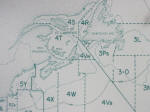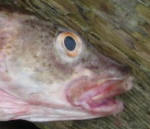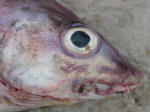|
The Downturn of the Atlantic Cod (Gadus
morhua) in Eastern Canada |
||
|
|
 20" cod, arched back, flat stomach (click thumbnails for larger views) |
 19.5" cod, emaciated bottom-feeder? |
|
Atlantic cod caught recently in Nova Scotia, besides appearing very lean, are showing a strange body shape, with the back arched and the head turned down, in contrast to the classic appearance of the species. Cod now looks more decidedly like a bottom-feeding fish than it did in the past. Fish stock assessment scientists see a recent dramatic downturn in the numbers of Atlantic cod…but surprisingly, a ‘downturn’ can also literally be seen in the faces of individual codfish...as these fish struggle to adapt to the current poverty of their normal prey fish in the ocean(?) Perspective: A decade ago, cod stocks “crashed” in Atlantic Canada, an event generally agreed to have been the result of “overfishing." Despite a ten year fishing moratorium, however, these stocks are showing no convincing signs of recovery. Most perplexing, perhaps, is the continued, and increasingly acute, absence of older, mature fish from these stocks. With 10 years to grow without fishing pressure, there should now be a significant stock component of larger adult fish. But there is not…and in fact the oldest age now attained by cod on the Grand Bank of Newfoundland, is less that it was ten years ago. Stock assessment indicators for cod in general continue to fall. Why? ...Might they really be simply 'starving?' A look at cod on the Scotian Shelf (Atlantic coast of Nova
Scotia): An informal look at two lots of Atlantic cod caught by a commercial
fisherman on the Scotian Shelf during late summer of 2002, may reveal an
important clue, since the profile of cod seems to be literally changing.
The cod fishery on the “Eastern Scotian Shelf” (4VsW) remains closed (under
moratorium since 1993) but a greatly scaled back cod fishery continues in
bordering area “4X” which extends from Halifax southwestward, and includes the
naturally more productive Southwest Nova/Bay of Fundy area. (click on map
at right to enlarge) The fish that I examined were caught near the
northeastern limit of “4X” in waters bordering on the closed area, “4VsW". The Eastern Scotian
Shelf has become known to fishermen and scientists in recent years for the
“baffling” production of “slinky” cod, fish in "very poor
condition." (quotes from DFO) It seems likely that these poor-looking cod
caught in eastern 4X are similar to their “slinky” relatives in 4VsW. August 8, 2002 (fish from 44:04N, 64:02W, in photo at right above) - I wanted to photograph profiles of cod for gross comparison to DFO’s photo (left) in which well-fed and starved cod are contrasted. It was a surprise to find that the fresh-caught cod (on baited longline) resembled neither the well-fed nor the lab-starved examples from DFO, neither did these fish appear as intermediate forms between the two extremes. Besides appearing lean, the cod caught in early August appears rather to have a grossly altered body shape ~ a flattened stomach profile and almost a ‘humpback’ in comparison to the standard codfish shape. The orientation of the head is more downward-looking, giving the overall impression that this fish is a bottom-feeder. (However, this particular fish was 20 inches long, a size at which cod are known to normally feed primarily on fish, in contrast to the small invertebrates that prevail in the diet of younger cod. (Liem and Scott, 1966) For what it’s worth, the stomach of this fish contained only one very small crab and one small shrimp.)
What are cod eating in Atlantic Canada today? This is surprisingly difficult to ascertain from the literature, as recent publications from DFO seem to reveal more interest in what seals are eating than in what cod are eating. Routine fish stock assessment reports do not include dietary assessments, although growth rates and "condition factors" are now regularly included, which is helpful. The growth rate of 4VsW cod has declined substantially, with fish in the 1970s growing to 68-72cm in 7 years, but recently reaching only 54-59 cm at that age. (DFO, 1998) Recent scientific investigations into the failure to thrive of Atlantic cod have focused on two likely causes of increasing natural mortality: (1) excessive seal predation and (2) adverse environmental conditions, which lead directly and indirectly to poor survival of fish (often ultimately starvation). (FRCC, 2002) These two suspected causes of high natural mortality in cod are unrelated, and should theoretically result in OPPOSITE physical effects on individual fish. This is an important insight, which should help to distinguish between the two scenarios. 1. Regarding seal predation: According to conventional thinking, and past observations, if predation (natural or human) lowers fish population numbers below the level that the system can naturally support, the surviving fish are left in better-than-average physical condition. This is because each fish experiences a relatively greater availability of food, once the competition has been lessened. Prior to recent years, a pattern had long been noted in fishery science that when fish populations had been over-harvested and were at low abundance for this reason, that the individual fish remaining were unusually plump. Whether the excessive predation is from human fishing or seals feeding, this effect on the condition of individual fish should be the same. Extreme degrees of seal predation, if this is what is occurring, should be associated with exceptionally good condition of the remaining cod. Recently and unexpectedly, however, cod and many other fish have been found to be simultaneously at low abundance and in poor condition. 2. Regarding adverse environmental conditions: If the growth of cod is being restrained by high natural mortality due to “adverse environmental conditions,” this implies that individual fish will likely be highly stressed, and predisposed to conditions such as post-spawning mortality (no energy reserves) as well as greater mortality from factors such as parasites and infections, and also predation (weaker specimens are less able to escape predators). A fish population so affected wherein individuals are undernourished will actually benefit - 'condition-wise' - by having its numbers reduced, since food availability to individuals will be increased. So seal predation, rather than hurting, may actually benefit a fish population that is suffering from a shortage of food. (A lower number of spawning fish in better condition may be better equipped to maintain the species than a higher number that are dying of starvation.) Therefore, making the wrong decision and removing seals in a situation of severe "adverse environmental conditions" might actually work to aggravate the poor physical condition of cod... Recent biological data on Atlantic cod indicates generally slowed growth, and poor "condition" (or fat reserves) of the few remaining fish. (See publications of the Canadian Department of Fisheries and Oceans (DFO) and the Fisheries Resource Conservation Council (FRCC).) This finding does not support, but rather contradicts, the currently favored hypothesis that seal predation is now preventing the growth and "rebuilding" of these fish stocks. Regardless, it appears that the announcement of a seal cull to "aid" the groundfish recovery in Atlantic Canada is imminent:
"The council is still of the opinion
that the large numbers of seals are impeding groundfish recovery."
FRCC.2000.R.5 However, judging by the appearance and condition of the fish, "adverse environmental conditions," now seem certain to be the cause of the poor growth of cod stocks. It is most commonly suggested that what is "adverse" is water temperature (if too low, fish feeding is suppressed). But the "adversity" could also be a decline in overall system productivity, which could result from various factors including climate change or altered patterns of water circulation. (These two factors have not changed dramatically in Atlantic Canada. My hunch is rather that system productivity has been relentlessly lowered by centuries of fishing, which has induced a general decline in marine nutrient cycling. Most scientists will disagree with my suggested 'cause' but that is not the main point...the first order of business is determining whether or not a significant lowering of marine productivity has occurred. Because if it has, it is very important that this be acknowledged.) Do these observations on the changed physical shape of Scotian Shelf cod offer a useful insight into why the stocks are failing to “rebuild?” The altered appearance of today's Atlantic cod should help to tease apart the possible causes of their failure to thrive. A direct "environmental" affect on cod feeding, such as cold water or lowered oxygen, might induce the fish to eat less of its normal prey even though adequate prey existed (appetite suppression?)...but a more indirect "environmental effect" on cod would result from lowered system productivity; in which case fish would simply be faced with a lower abundance of their normal prey (normal appetite, just cannot find enough to eat?). This seems most likely to be the problem, based on physical assessment of the fish. In the case of lowered system productivity (a much more worrisome "environmental" situation), changes would be expected to also occur across all other species, and this does appear to be the case. Although my observations may be dismissed by some as “anecdotal” and my conclusions as “mere speculation”…here is my interpretation of what is most likely happening now to Atlantic cod off eastern Canada: - A declining availability of their normal prey in the water column (essentially all small fish, cod are not discriminatory) is forcing cod to continue bottom-feeding as they enter adulthood. This repetitive behavior (looking downward, rooting for food in the bottom sediment) has actually caused the fish to grow now into an unusual shape with a markedly down-turned head, as compared to the classic codfish look (normally adult cod have the mouth oriented forward as befits one who pursues prey fish and snatches them from the water.) Cod are not nearly as well suited physically to the intensive bottom-feeding style as are fish such as haddock, for instance, which may help to explain why cod stocks are faring worse than haddock stocks today. - Rooting in the bottom for food (not the normal manner of acquiring prey by adult cod) has possibly also caused unusual abrasion or inflammation around the mouth, therefore the reddened appearance of the mouths of the cod in the recent photos. (Note the contrast below between the facial structures of normally-fish-eating cod (left) and normally-bottom-feeding haddock (right): haddock has a much bigger eye and almost a 'beaked' mouth for digging in the mud, hence it seems that it will feed more successfully than cod under today's conditions: 'mandatory bottom feeding?') - Laboratory studies are unlikely to reveal the whole picture in nature, as starving a cod in a tank merely resulted in a very lean fish, but one with the normal forward orientation of its head. Starving cod in the ocean, on the other hand, changes the profile of cod, as pelagic-feeding adults lower their heads in a struggle to survive by feeding at a lower trophic level (bottom invertebrates). Besides offering a contradiction to current thinking that cod are feeding poorly due to a direct effect of water temperature, the observation of this particular physical change seems to discredit another current hypothesis: that fish growth has slowed because a genetic shift towards slower-growing individuals has been induced by the "size-selective culling" effect of fishing gear. - A gradual lowering of overall marine productivity would be expected to induce broad changes in the cod population that are consistent with those that have already occurred. For example: a long, downward trajectory including contraction of the range of the species, with the remainder of the population concentrated in those areas that are relatively mid-range and are naturally richest. The northernmost extreme of the range is where cod disappeared first: the commercial cod fishery collapsed in Labrador a decade before the major Newfoundland "crash" in 1992. (FRCC, 2000) The offshore component of Newfoundland cod is now in desperate condition, while inshore components are growing reasonably well only in a few large bays (areas where production is enhanced by terrestrial runoff). In Nova Scotia the best growing cod are concentrated in the Bay of Fundy where the topography naturally enhances marine production. This pattern would be predicted under a scenario of declining ecosystem productivity, as would the prey-switching to organisms living at 'lower' points in the food web, which seems evident in Scotian Shelf cod today. - What about the other natural predators of small marine fish? All of these would be expected to be similarly stressed, and possibly also switching to bottom-prey. One visible example of this in Nova Scotia is the common cormorant, a fish-eating bird that is now seen fishing inside all of the shallow inlets along the Atlantic coast, in contrast to decades ago when these birds were mainly seen near coastal islands. But if the only food can now be obtained by diving to the bottom, the birds will save energy by fishing in the very shallowest coastal areas. Most often cormorants will now surface with small crabs, rather than fish, in their beaks, and the crab seems to be quite an awkward meal for them to consume compared to the ease with which these birds can gulp down small fish...they usually rip one leg off and then lose the thing....(Aside: strange behavior in marine wildlife includes this cormorant who tried unsuccessfully to eat hot dog pieces offered by the author.) (Further aside: how did this codfish paper stray into a discussion of cormorants?...only because it must; the entire ecosystem needs to be considered to make sense of anything.) - The lack of small prey fish seems most likely to have resulted from a decline in the abundance of their major prey, zooplankton, which implies a decline in productivity of the whole ecosystem. The interpretive stumbling block which remains, to those following classical reasoning, is “why are zooplankton declining when their food, phytoplankton, appears to be at an unusually high abundance?” Is this where the food web has become unhinged, at the point between phytoplankton and zooplankton? How can this be? Well…it’s complicated, but the strength and nature of the interdependence of zooplankton and phytoplankton is just one aspect of marine ecology that perhaps needs to be reassessed now…and, especially in Atlantic Canada, it is impossible to convincingly explain the recent dramatic shift in the marine food web by either “global warming” or “pollution.” It seems more likely to simply have been the ultimate result of centuries of heavy fishing…a result which should have been predictable had we correctly grasped how the ecosystem works. (We have largely failed to appreciate the ecological role of fish in supporting zooplankton, and indeed in enhancing basic nutrient cycling/ecosystem productivity…because we thought that mature fish were “surplus,” i. e. removing them would not weaken the system, or negatively affect organisms smaller than themselves. It looks like we were wrong about that. Today’s trends are showing us what can be produced by a fishless sea…and it’s NOT a great excess of the lower forms that would normally be their prey…the declining trends in formerly dominant marine species can even be detected in barnacles and seaweeds (check out the seaweed photo galleries). - The scientists responsible for assessing and protecting the health of marine life urgently need to address the question of significantly declining marine productivity that may have already occurred. This theory challenges the usual view, but unfortunately it seems that overwhelming evidence supports it. Regardless of how unpleasant this issue might be, we need to honestly look at all of the facts and ask the questions: "What if we have been wrong about what 'drives' marine productivity?" "What if the current failure of the Atlantic cod is essentially due to simple starvation?" See also: DFO diagnoses starvation in
cod, 2004, a realization that exonerates seals of blame for the failed
stock recovery My thanks are due to Bill Bell, skipper of the F/V "J. J. Happy," for much helpful information and support, and access to his fish catches. Copyright Debbie MacKenzie, 2002 References: DFO, 1998. "Eastern Scotian Shelf Cod" DFO Stock Status Report A3-03 (1998) (online at: http://www.dfo-mpo.gc.ca/csas/csas/status/1998/a3-03e.pdf ) FRCC.2000.R.5 "Uncharted Waters" Annual Report of the Fisheries Resource Conservation Council and Conservation Requirements for Atlantic Groundfish Stocks for 2000. FRCC.2002.R.1 "2002/2003 Conservation Requirements for Groundfish Stocks on the Scotian Shelf and in the Bay of Fundy (4VWX), in Sub-Areas 0, 2 + 3 and Redfish Stocks" (online at: http://www.dfo-mpo.gc.ca/frcc/2002/jan2002e.pdf ) Liem, A. H. and W. B. Scott. "Fishes of the Atlantic Coast of Canada." Fisheries Research Board of Canada, Bulletin No. 155. Ottawa, 1966. |
||






